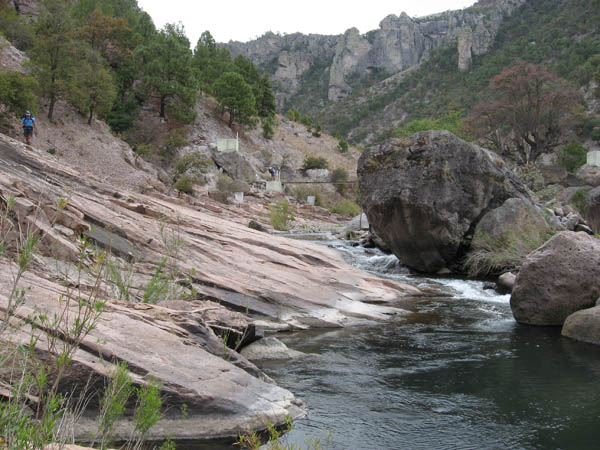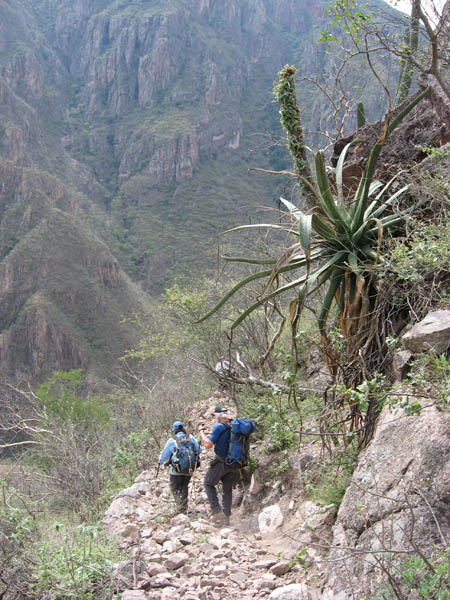
STEPPING LIVELY in VERTICAL COUNTRY
What You Didn't Know You Knew About Hiking
 |
Hiking in Mexico's Copper Canyon gives you a rush like your first carnival ride on the Himalaya. Or more like the Spinning Barrel where the bottom drops out from beneath you! There's the same adrenaline rush you get as you tip off into a vertical mile of limitless hiking opportunities. The terrain is steep. Some trails are steeper than those in Arizona's Grand Canyon, but not as well maintained. The trails are maintained, though. If the monsoons wash out a trail, a work party will be organized to repair the damage. They may have to roll some rocks into place, or fell a tree against some standing trees to stabilize a loose hillside, and then roll rocks into place. Whatever it takes, they'll get it done! These crews are made up of local Indians, the Tarahumara. They need the trails to go about their daily routine, and luckily, they're very efficient...once they get organized. We'll get to that, later.
Alot of the trails are on solid rock, but many parts are made up of loose cobbles. These softball sized rocks called baby-heads or rollers, make hiking downhill somewhat akin to a controlled slide. Just keep your knees a little bit flexed. Think of it as scree skiing. The countless critters in these canyons are constantly loosing rocks, boulders, pebbles, and debris on their gravitationally aided journey to the sea. The locals all keep goats. If you've ever seen domestic goats, you know how agile they are. They nonchalantly scamper from one death-defying position to another to nibble a tuft of grass here, or a low hanging leaf there. But Apache warriors they aren't! If you're not hiking, but quietly sitting, catching your breath for instance; you can tell a long way off when a herd of goats is coming. It's not just the tiny bells, or the bleating that sounds like an abandoned child; it is the sound of rocks falling and crashing through the leaves of the trees around you. Remember, this is canyon country, so if the goats aren't below you, they'll be on the trail you are on; and once they see you they going to head for higher ground. Or they may be high above you, so you have to be on the lookout for rocks rolling, bouncing, careening down the hillside. If you hear a bouncing rock, try to get a fix on it. Yell out "ROCK" to your hiking companions, point your finger if you can, and follow it with your eyes.
Cows, burros, and horses are also actively aiding erosion. If you're on a burro assisted hike, or passing one, you can see how wide these critters are once they have a duffel or crate tied to each side. If you scare them off trail, they'll go crashing through the scrub oaks, and loosen all manner of debris. If you see a burro train approaching, stand or sit quietly, preferably on the uphill side until they pass.
 |
Some people hike with a stick or a pair of poles. Just remember it is an aid and not a crutch. Be prepared to drop it if it gets in the way. It can just as easily get jammed between boulders and pull you off balance. It's best to use it on the downhill side. Be aware of the strap, if it comes with one. If you fall and your arm is stuck in the strap, you could turn a few scrapes and bruises into a dislocated shoulder. Going downhill, it can help to keep you descending slowly. It can maintain two points of contact with the ground if your foot rolls off a cobble. If you've got a heavy pack, it can ease the strain on your knees lowering yourself over some of those huge steps. Going the other way, it can help catapult you up those burro-sized steps.
SO now you're on the rim, and the burros have passed and you're ready to drop in. Your pack is balanced and cinched; no chafe points. You've got water at hand, but you've got your hands free. What's next? Time to cinch your shoes. Take your pack off and lean it against a tree. Then start at the toes of your boots and pull the laces to get the slack out. Every step of the descent is going to push your toes to the front of your shoes. Three weeks before now you should have trimmed your toenails; forget the pedicure. If you haven't trimmed your toenails previously, now is not the time!
The fun thing about canyon travel is that you're going downhill with a heavy pack. You eat your way to a lighter pack, and get in better shape, for the uphill leg. You would never know how far and fast you were going down hill until you turn around and start up, and realize that the air at 7000 feet is thin. Things happen quickly at this elevation, so be prepared. The wind on a sweaty body at this elevation is cold, so your daypack should include a sweater and a windbreaker. You perspire a lot of water and don't know it until you get a headache. Take plenty of water, and drink it- often. They say if your urine isn't clear, you're not drinking enough. Also, the sun at elevation is stronger. Protect your ears and your neck. And, if you don't take care of your feet, you might not only be in excruciating pain, you could compromise the entire trip.
Your feet are your friends. Hiking, they are more like your bosom buddy. Pamper them. Buy them some nice boots, but make sure they are broken in before attempting a big hike. Some people like to hike in tennis shoes, or cross trainers or trail runners, or (egads!) sandals. These offer lots less ankle support, and if you slip off a rock, all that extra weight ends up on your ankle. Sandals have the added disadvantage of letting pebbles in the footbed, and of still letting you stub your toe. Make no mistake, in the bottom of the canyon, you'll be in the water. Sandals with neoprene socks are fine, but I prefer an old pair of tennis shoes for river crossings. Pamper your feet some more. Get them a nice pair of socks or three, and keep one pair just for dry shoes in camp and the tent. Maybe, if you love your feet, you could even get them some really cushiony insoles to replace the generic ones that usually come stock. Maybe even some wicking liner socks. Granted, sock manufactureres are going a little overboard lately whatwith 3-day versus 5-day socks, and trail running versus light hiking, but remember: your feet are your friends.
The only thing to do now is start hiking. Keep you eyes on the trail maybe three to four steps ahead. Avoid the big round cobbles. If it looks like it might roll, it probably will. Avoid loose pebbles and sand on flat rocks. Keep your knees bent slightly to absorb the jarring to your body. If you feel a hot spot on your feet, address it immediately! Remember where the hotspot is while taking off your shoes and socks. If you catch it early enough some tape might be all you need, or a minor adjustment. It's a good idea to have "moleskin" or "molefoam" and a pair of scissors or a knife. Copper Canyon trails are miles of loose rocks. It's a kind of triage to pick the least bad route. Don't forget to stop and admire the view. Just don't forget to STOP, or the bottom may drop out from beneath you!